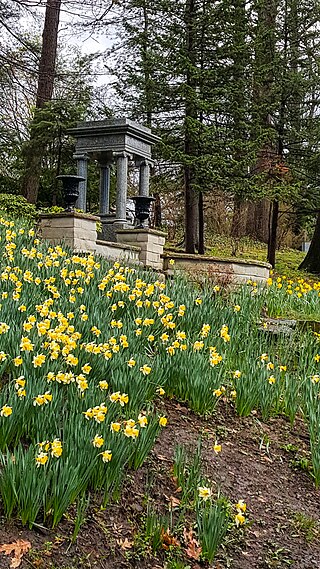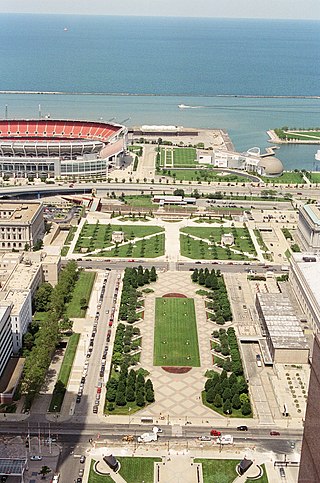
The Bert L. and Iris S. Wolstein Center is a 13,610-seat indoor arena located in downtown Cleveland, Ohio, United States, on the campus of Cleveland State University (CSU). It is home to the Cleveland State Vikings men's and women's basketball teams and previously served as the home of the Cleveland Crunch of the National Professional Soccer League and Major Indoor Soccer League from 1992 to 2005 and the Cleveland Charge of the NBA G League from 2021 to 2024.

Public Auditorium is a multi-purpose performing arts, entertainment, sports, and exposition facility located in the civic center district of downtown Cleveland, Ohio. The 10,000-capacity main auditorium shares its stage with a second venue housed at the facility: the 3,000-capacity Music Hall, and as of 2024 serves as the home arena to the Cleveland Charge of the NBA G League. Although Public Auditorium was planned and funded prior to World War I, construction did not begin until 1920, and the building did not open until 1922. Designed by city architect J. Harold McDowell and Frank Walker of Walker and Weeks in a neoclassical style matching the other Group Plan buildings, it was the largest of its kind when opened, then seating 11,500.

Samuel Andrews (1836–1904) was a chemist and inventor. Born in England, he immigrated to the United States before the American Civil War and settled in Cleveland, Ohio. He is best known as a partner in the oil refining firm of Rockefeller, Andrews & Flagler, the major predecessor company of the Standard Oil corporate empire. When the first unit was formed in 1870, Andrews owned 16.67% of Standard Oil stock. He sold his stock early on in 1874 and while he was wealthy, he did not participate in the level of wealth generation that the other founders did.

SITE Centers Corp. is a publicly traded real estate investment trust that invests in shopping centers. Founded in 1965 by Bert Wolstein, the company is headquartered in Beachwood, Ohio. As of December 31, 2019 the company owned interests in 170 shopping centers in the United States containing 57.0 million square feet and managed 13.2 million square feet for Retail Value Inc. Notable properties wholly owned by the company include Shopper's World in Framingham, Massachusetts. Its major tenants include retailers such as TJX Companies, PetsMart, Dick's Sporting Goods, Ulta Beauty, Ross Stores, and Nordstrom.
Richard E. "Dick" Jacobs was an American businessman and real estate developer who co-founded the Jacobs Entertainment, Inc., Richard E. Jacobs Group, and owner of the Cleveland Indians from 1986 to 1999.
The George Gund Foundation is a charitable foundation established in 1952 to provide grants in the areas of the arts, civic engagement, community development, economic development, environmental policy, and human services, public education, racial inequality. As of 2019, the foundation had made grants totaling more than $722 million since its inception. It is the second-largest charitable foundation in Cleveland.

The original Cleveland Force was one of six charter franchises in the original Major Indoor Soccer League (MISL). The team played from 1978 to 1988 at the Richfield Coliseum, the home of the Cleveland Cavaliers, and regularly drew crowds in excess of 12,000 in the mid-1980s.

Lake View Cemetery is a privately owned, nonprofit garden cemetery located in the cities of Cleveland, Cleveland Heights, and East Cleveland in the U.S. state of Ohio. Founded in 1869, the cemetery was favored by wealthy families during the Gilded Age, and today the cemetery is known for its numerous lavish funerary monuments and mausoleums. The extensive early monument building at Lake View helped give rise to the Little Italy neighborhood, but over-expansion nearly bankrupted the burial ground in 1888. Financial recovery only began in 1893, and took several years. Lake View grew and modernized significantly from 1896 to 1915 under the leadership of president Henry R. Hatch. The cemetery's cautious management allowed it to avoid retrenchment and financial problems during the Great Depression.
George Gund II was an American banker, business executive, and real estate investor who lived in Cleveland, Ohio, in the United States. He inherited his father's fortune and used a portion of it to purchase alien property seized during World War I. He sold this business at significant profit, and invested widely in banking, insurance, and real estate. Among his investments were a large number of shares in the then-small Cleveland Trust Company. Gund became a director of the bank in 1937 and president in 1941. He led the transformation of the institution into one of the largest banks in the United States. He retired as president in 1962, and was named chairman of the board of directors. A philanthropist for most of his life, he established The George Gund Foundation in 1952.
Chaim Schochet is an American real estate executive, developer, and manager at Optima Ventures, once the largest holder of real estate in Downtown Cleveland.

Robert L. Stark is an American real estate developer and founder and chief executive officer of Stark Enterprises.

The Cleveland Trust Company Building is a 1907 building designed by George B. Post and located at the intersection of East 9th Street and Euclid Avenue in downtown Cleveland's Nine-Twelve District. The building is a mix of Beaux-Arts, Neoclassical, and Renaissance Revival architectural styles. It features a glass-enclosed rotunda, a tympanum sculpture, and interior murals.

Mayfield Cemetery is a historic Jewish cemetery located at 2749 Mayfield Road in Cleveland Heights, Ohio. Established in 1890, it is one of the largest Jewish cemeteries in Cuyahoga County and the only Jewish garden cemetery. A chapel was constructed in 1893. This was demolished and a large mausoleum, which included a chapel, was built in 1930.

The Cleveland Convention Center was located in downtown Cleveland, Ohio. Built by the city of Cleveland beneath the Cleveland Mall adjacent to Public Auditorium, it was completed in 1964. Plans for the convention center were first made in 1956, but voters twice rejected initiatives to fund construction before approving a bond levy in November 1963. A local private foundation donated several million dollars to beautify the mall atop the convention center with a reflecting pool and fountains.

The Bingham Company Warehouse is a historic warehouse located in Cleveland, Ohio, in the United States. It was designed by the noted local firm of Walker and Weeks for the W. Bingham Company, and is one of the architectural firm's few utilitarian commercial buildings. For many years, W. Bingham Co. was the Midwest's largest hardware manufacturer and wholesaler. The W. Bingham Co. went out of business in 1961, and the warehouse was sold to a succession of owners of the years. The warehouse was sold to private investors in 2001, who converted it into apartments, known today as The Bingham.

The H. Black and Company Building is a historic former factory building located in Cleveland, Ohio, in the United States. It was commissioned by H. Black and Company, one of the largest manufacturers of women's clothing in the United States, and designed by noted New York City architect Robert D. Kohn. Completed in 1907, it won national praise for its design. The building was sold in 1928 to the Evangelical Press, and for a short time was known as the Evangelical Press Building. The commercial printing business of the Evangelical Press was spun off as a secular company, Tower Press, in 1934, after which the structure became known as the Tower Press Building. Vacant for much of the 1960s and 1970s, the building had two different owners in the 1980s and was nearly demolished. A new owner took over the building in 2000, after which it underwent an award-winning renovation and restoration. The structure was added to the National Register of Historic Places on January 24, 2002. The structure now serves as a mixed-use development for low- and moderate-income artists.

The Cleveland Foundation Centennial Lake Link Trail, originally known as the Lake Link Trail, is a cycling, hiking, and walking trail located in the city of Cleveland, Ohio, in the United States. Owned by the city of Cleveland and maintained by Cleveland Metroparks, the trail runs along the former track bed of the Cleveland and Mahoning Valley Railroad. The trail is named for The Cleveland Foundation, a local community foundation which donated $5 million toward the trail's construction. The southern leg of the 1.3-mile (2.1 km) trail opened in August 2015, and the northern leg in August 2017. The middle leg will begin construction once the Irishtown Bend hillside is stabilized. A bridge connecting the trail to Whiskey Island will begin construction in Spring 2019 and will be completed in early Summer 2020.

The Cleveland and Mahoning Valley Railroad (C&MV) was a shortline railroad operating in the state of Ohio in the United States. Originally known as the Cleveland and Mahoning Railroad (C&M), it was chartered in 1848. Construction of the line began in 1853 and was completed in 1857. After an 1872 merger with two small railroads, the corporate name was changed to "Cleveland and Mahoning Valley Railroad". The railroad leased itself to the Atlantic and Great Western Railway in 1863. The C&MV suffered financial instability, and in 1880 its stock was sold to a company based in London in the United Kingdom. A series of leases and ownership changes left the C&MV in the hands of the Erie Railroad in 1896. The CM&V's corporate identity ended in 1942 after the Erie Railroad completed purchasing the railroad's outstanding stock from the British investors.

The Halle Building, formerly known as the Pope Building and after 2014 as The Residences at Halle, is an 11-story Chicago School mixed-use structure located in the Downtown Cleveland central business district in Cleveland, Ohio, in the United States. Designed by architect Henry Bacon, the building was the flagship department store of the Halle Brothers Co. from 1910 to 1982.

John A. Spitzer was an American automotive executive and real estate developer.

















